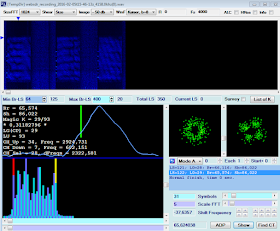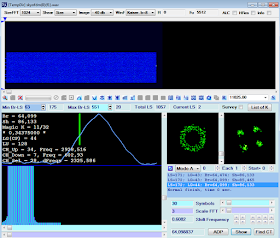Unid FSK 35.5Bd/1000 heard in idling mode on 10550 KHz (CF) and recorded using the KiwiSDR located in Kuopio, Finland.
The raster shows a distortion of the manipulation speed which is also visible in the phase detector (Fig. 2): most likely a native defect of the source modem/transmitter.
The raster shows a distortion of the manipulation speed which is also visible in the phase detector (Fig. 2): most likely a native defect of the source modem/transmitter.
 |
| Fig. 1 |
 |
| Fig. 2 |
Although quite uncommon, the baud rate is 35.5 Bd, as shown in Figure 3 where I isolated and analyzed a "clean" signal segment. It's the first time for me I meet such speed in a FSK waveform (only in CIS-60 HDR modem) but it must be said that there is a possibility that the speed will change when switching from idle to traffic mode (as the old BEE 36/50 did), unfortunately during my listening the signal remained in idle mode.
 |
| Fig. 3 |
As for the source of the signal, it is reasonable to think of a Russian user since the shift of 1000 Hz is used in waveforms such as CIS-14, Vezha-S and also Akula as well as used by Rus-AF (1). Nevertheless, Indian Navy too (VTH9) uses 1000 Hz shift in their FSK 50Bd transmissions.
Although I have been keeping an eye on that frequency, to date I have not yet had the opportunity to hear this signal again.
kiwi-kuo.aprs.fi_2020-01-23T10_26_37Z_10548.50_usb.wav
(1) REA4 Moscow AF HQ uses FSK 50Bd/1000 in idling between skeds in FSK Morse (5FGs).
Although I have been keeping an eye on that frequency, to date I have not yet had the opportunity to hear this signal again.
kiwi-kuo.aprs.fi_2020-01-23T10_26_37Z_10548.50_usb.wav
(1) REA4 Moscow AF HQ uses FSK 50Bd/1000 in idling between skeds in FSK Morse (5FGs).
















